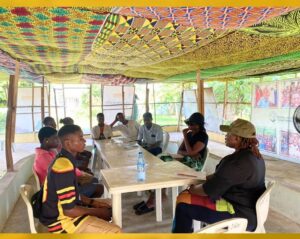Why you should aim for system change, also when you ‘only’ work in the communities in your region.
By Tony Joy
At Durian, our Theory of Change is that:
𝑰𝒇 𝒘𝒆 𝒄𝒓𝒆𝒂𝒕𝒆 𝒔𝒚𝒔𝒕𝒆𝒎𝒔 𝒕𝒉𝒂𝒕 𝒄𝒐𝒏𝒏𝒆𝒄𝒕 𝒓𝒖𝒓𝒂𝒍 𝒓𝒆𝒔𝒐𝒖𝒓𝒄𝒆𝒔 𝒕𝒐 𝒌𝒏𝒐𝒘𝒍𝒆𝒅𝒈𝒆, 𝒏𝒆𝒕𝒘𝒐𝒓𝒌𝒔, 𝒕𝒆𝒄𝒉𝒏𝒐𝒍𝒐𝒈𝒚, 𝒂𝒏𝒅 𝒔𝒌𝒊𝒍𝒍𝒔, 𝒕𝒉𝒆𝒏 𝒓𝒖𝒓𝒂𝒍 𝒘𝒐𝒎𝒆𝒏 𝒂𝒏𝒅 𝒚𝒐𝒖𝒕𝒉 𝒘𝒊𝒍𝒍 𝒊𝒏𝒄𝒓𝒆𝒂𝒔𝒆 𝒕𝒉𝒆𝒊𝒓 𝒊𝒏𝒄𝒐𝒎𝒆, 𝒄𝒐𝒏𝒇𝒊𝒅𝒆𝒏𝒄𝒆, 𝒂𝒏𝒅 𝒍𝒆𝒂𝒅𝒆𝒓𝒔𝒉𝒊𝒑 𝒄𝒂𝒑𝒂𝒄𝒊𝒕𝒚; w𝒉𝒊𝒄𝒉 𝒘𝒊𝒍𝒍 𝒍𝒆𝒂𝒅 𝒕𝒐 𝒔𝒕𝒓𝒐𝒏𝒈𝒆𝒓 𝒍𝒐𝒄𝒂𝒍 𝒆𝒄𝒐𝒏𝒐𝒎𝒊𝒆𝒔 𝒂𝒏𝒅 𝒖𝒍𝒕𝒊𝒎𝒂𝒕𝒆𝒍𝒚 𝒖𝒏𝒍𝒐𝒄𝒌 𝒓𝒖𝒓𝒂𝒍 𝒕𝒓𝒂𝒏𝒔𝒇𝒐𝒓𝒎𝒂𝒕𝒊𝒐𝒏.
A Theory of Change explains how and why a desired change is expected to happen. A Theory of Change also helps you identify what needs to be in place for your goal to happen. These are called assumptions or preconditions. This framework ensures that every activity you implement is aligned with the bigger picture. Without it, we risk working hard but not necessarily making meaningful progress.
 Because I work within the realm of Nigeria’s rural communities, that does not mean my insights and impact stays within these boundaries. Rather the contrary, by making my way of changing communities explicit, I envision to unlock rural transformation around the globe.
Because I work within the realm of Nigeria’s rural communities, that does not mean my insights and impact stays within these boundaries. Rather the contrary, by making my way of changing communities explicit, I envision to unlock rural transformation around the globe.
That’s why I’m sharing 4 powerful elements of my way of revolutionising rural life with you, community change makers, in this blog.
Let’s start with the problem.
𝐏𝐫𝐨𝐛𝐥𝐞𝐦 𝐓𝐫𝐞𝐞 𝐀𝐧𝐚𝐥𝐲𝐬𝐢𝐬: 𝐅𝐢𝐧𝐝𝐢𝐧𝐠 𝐭𝐡𝐞 𝐑𝐨𝐨𝐭 𝐂𝐚𝐮𝐬𝐞
The Problem Tree Analysis helps us break down complex problems in communities to uncover their real causes.
It’s a visual tool that allows us to see how challenges are interconnected rather than isolated.
It has three parts:
🌱 The roots- the underlying causes of the problem
🌳 The trunk- the core problem itself
🍃 The branches- the visible effects or symptoms
This approach prevents us from treating symptoms while leaving the causes untouched.
For example, instead of saying “farmers are poor,” a problem tree might reveal deeper causes such as lack of land rights, poor storage systems, or unfair market structures.
By understanding the root causes, we can design interventions that create long-term solutions, not temporary relief.
💭 Think about it- Are you solving the problem itself or just managing its symptoms?
Logical Framework (Logframe) – Turning Vision into Measurable Action
The Logical Framework, often called a Logframe, is a structured tool for planning, managing, and measuring your community project.
It organizes your work into clear, connected levels that show how each action leads to impact.
Here’s how it works:
🎯 Goal – the long-term change you want to see
🎯 Objectives – the pathways to achieving that goal through the project
📈 Outcome – what will happen as a result of your project
📦 Output – the tangible results of your activities
🛠️ Activities – what you actually do day-to-day
The Logframe brings clarity, structure, and accountability.
It connects every task to a measurable result, helping both teams and donors understand the logic behind the project.
When used correctly, it transforms good ideas into well-structured, trackable actions.
💭 If you placed your project in a Logframe today, would the path from activity to impact be clear?
Results Chain: Connecting Resources to Results
The Results Chain helps us visualize how our resources lead to meaningful change.
It shows the logical flow from:
💡 Inputs (resources) → ⚙️ Activities → 📦 Outputs → 📈 Outcomes → 🌍 Impact
This chain encourages us to ask critical questions:
Are our activities producing the expected outputs?
Are these outputs leading to real outcomes?
Is the impact aligned with our original goal?
In community development, understanding the Results Chain ensures that every action contributes meaningfully to long-term change.
It’s a reminder that success isn’t random — it’s a sequence of deliberate, connected steps. Steps taken with or by community members
💭 Can you clearly trace the link between what you invest and the change you aim to achieve?
Stay tuned, there’s more to come!
